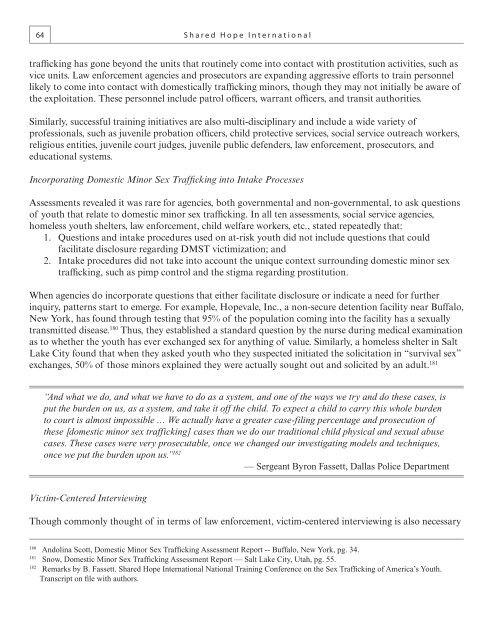By Linda A Smith Samantha Healy Vardaman Melissa A Snow
The National Report on Domestic Minor Sex Trafficking
The National Report on Domestic Minor Sex Trafficking
Create successful ePaper yourself
Turn your PDF publications into a flip-book with our unique Google optimized e-Paper software.
64Shared Hope Internationaltrafficking has gone beyond the units that routinely come into contact with prostitution activities, such asvice units. Law enforcement agencies and prosecutors are expanding aggressive efforts to train personnellikely to come into contact with domestically trafficking minors, though they may not initially be aware ofthe exploitation. These personnel include patrol officers, warrant officers, and transit authorities.Similarly, successful training initiatives are also multi-disciplinary and include a wide variety ofprofessionals, such as juvenile probation officers, child protective services, social service outreach workers,religious entities, juvenile court judges, juvenile public defenders, law enforcement, prosecutors, andeducational systems.Incorporating Domestic Minor Sex Trafficking into Intake ProcessesAssessments revealed it was rare for agencies, both governmental and non-governmental, to ask questionsof youth that relate to domestic minor sex trafficking. In all ten assessments, social service agencies,homeless youth shelters, law enforcement, child welfare workers, etc., stated repeatedly that:1. Questions and intake procedures used on at-risk youth did not include questions that couldfacilitate disclosure regarding DMST victimization; and2. Intake procedures did not take into account the unique context surrounding domestic minor sextrafficking, such as pimp control and the stigma regarding prostitution.When agencies do incorporate questions that either facilitate disclosure or indicate a need for furtherinquiry, patterns start to emerge. For example, Hopevale, Inc., a non-secure detention facility near Buffalo,New York, has found through testing that 95% of the population coming into the facility has a sexuallytransmitted disease. 180 Thus, they established a standard question by the nurse during medical examinationas to whether the youth has ever exchanged sex for anything of value. Similarly, a homeless shelter in SaltLake City found that when they asked youth who they suspected initiated the solicitation in “survival sex”exchanges, 50% of those minors explained they were actually sought out and solicited by an adult. 181“And what we do, and what we have to do as a system, and one of the ways we try and do these cases, isput the burden on us, as a system, and take it off the child. To expect a child to carry this whole burdento court is almost impossible … We actually have a greater case-filing percentage and prosecution ofthese [domestic minor sex trafficking] cases than we do our traditional child physical and sexual abusecases. These cases were very prosecutable, once we changed our investigating models and techniques,once we put the burden upon us.” 182— Sergeant <strong>By</strong>ron Fassett, Dallas Police DepartmentVictim-Centered InterviewingThough commonly thought of in terms of law enforcement, victim-centered interviewing is also necessary180Andolina Scott, Domestic Minor Sex Trafficking Assessment Report -- Buffalo, New York, pg. 34.181<strong>Snow</strong>, Domestic Minor Sex Trafficking Assessment Report — Salt Lake City, Utah, pg. 55.182Remarks by B. Fassett. Shared Hope International National Training Conference on the Sex Trafficking of America’s Youth.Transcript on file with authors.
















